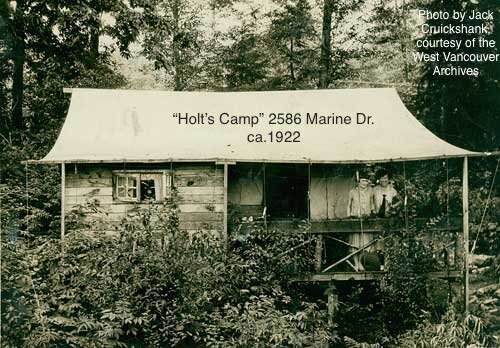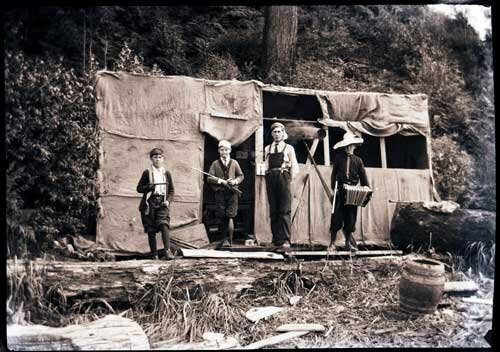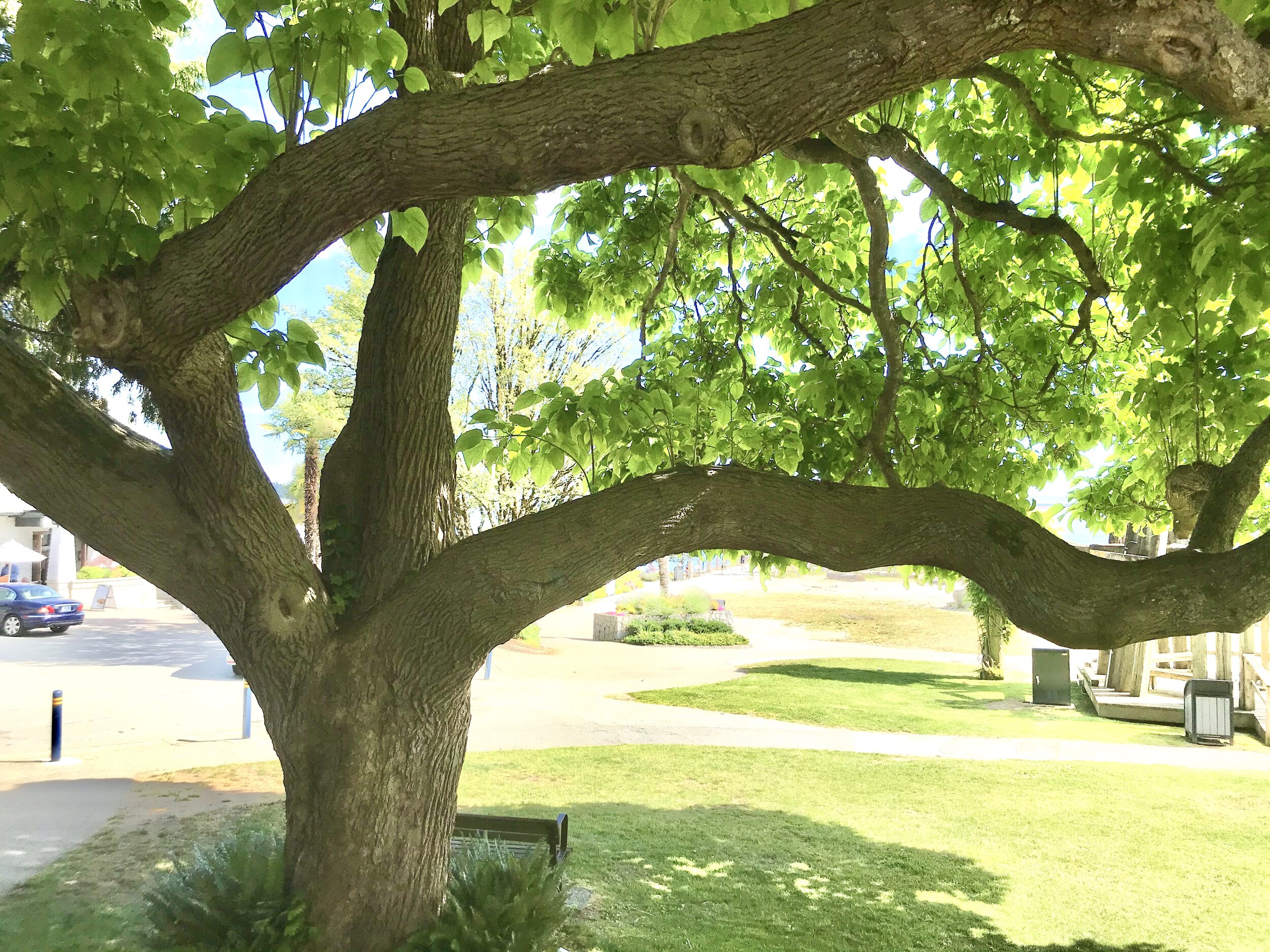If you were to go to Dundarave Beach today (at the very bottom of 25th St. in West Vancouver) and re-wind the clock back one century to the summer of 1921, you would see a vastly different landscape, save from the sand, the logs, the pier, and the building that is currently The Beach House Restaurant. These have all been there for over a century, but not much else is the same.
If you faced the ocean and looked east, you’d notice the waterscape looking rather wide and empty without the Lion’s Gate Bridge and heavy shipping traffic of container ships, although you might see a ferry heading over to Ambleside or Dundarave, bringing over summer revellers and campers from Vancouver.
Photo 356-1: Dundarave Beach looking east from foot of 25th St., 1919. Photo by the Thompson family courtesy of the West Vancouver Archives.
To your immediate right and left along the beachfront the palatial homes and apartment towers of today would be gone and you would see trees and bushes, small cottages and tents full of campers there for the season, a few days, or even a day trip for a picnic.
Some tents-like structures called “half and half’s” might look rather large and elaborate for typical camping, with cookstoves and chimneys, almost more shack-like than a tent, some of them used as a long-term campsite while waiting for a home to be built nearby. You’d see areas along the beach broken into small, individual camps with names such as Island View, Wings Point and Bide Awee on wooden signs. The air around these camps would smell of sea salt, coffee and cooking food, while the cheery sound of children singing songs together would ring through it.
Photo 484: Boys at a "cabin" known as the "Pirate Den" on the beach near 20th St. This is technically just outside the Dundarave boundary of 22nd St. to 28th St. but represents one of the types of imaginative dwellings that may have been seen along the beach at Dundarave. Standing second from right is the builder, Bert Thompson. Photo is by the Thompson Family courtesy of the West Vancouver Archives.
If you turned around to face the mountains you would see a mass of green, broken only by pockets of homes or cottages, with the majority of homes and shops on the southern slope, closer to the water.
To your right on the beach, just a few paces east of 25th St., you’d see the Clachan, a waterfront resort, and its little cottages, built by Scotsman Alan Stevenson and run by his sisters, Jessie and Helen Stevenson. It would have already been in business for 9 years by 1921. At any given moment, the Clachan was a flurry of activity, and you could see guests having tea in the glassed-in veranda, attending banquets and dances or just relaxing by swimming, boating and fishing at the beach.
Just to the left of 25th you’d see The Fortune Cup Inn, only two years old, an inn that also served tea and put on dances like its neighbour, the Clachan. The hall at the Fortune Inn was a popular spot for birthday parties and special events, and its long veranda was a perfect spot to unwind and watch a sunset in the evening after a long day of having fun. If you were there on August 7th you would’ve witnessed the glorious sunset Mary Lomas wrote about in a long editorial about the beach in the August 7th, 1921 edition of the Vancouver Sun “ ….we watched an unspeakably beautiful sunset fade and revive in a wondrous afterglow….Point Atkinson was silhouetted against a brilliant golden light that softened into a rose pink and was subdued by the night shades of purple that lengthened. In the distance Vancouver Island wrapt itself in a filmy wisteria mantle, and Point Grey’s outlines grey indistinct under a lavender shroud.”
If you happened to be at the beach in mid August you’d be lucky enough to take part in the biggest outdoor event of the summer, the Dundarave Regatta. Traditionally a Regatta is a boat race, but at Dundarave it began in 1917 as a small swimming competition for children.
By 1921 it was much bigger and more organised with numerous aquatics events. If you managed to find a place to sit or stand on or near the pier on August 20th, 1921, amongst the hundreds of spectators, you’d be able to witness a great many exciting events including swimming races, diving competitions, canoe tilting, and novelty races. You’d even get to see Professor Burrows of Kitsilano do his “Monte Cristo” act. I honestly don’t know what that was but it sure sounds intriguing!
Photo 0558: Dundarave Regatta, 1920. Photo by Rupert Harrison courtesy of the West Vancouver Archives.
In between events you might grab your friends and clown around for a funny keepsake photo and then enjoy some ice cream for a cool treat.
Photo 331: Clowning around for a beach photo, 1919. Photo by Kenneth Roblin courtesy of the West Vancouver Archives.
You’d end your eventful day by heading back to your camp, cottage, or resort room, having a bite to eat cooked on the fire, woodstove, or by your resort hosts, and flop into your sleeping bag or bed, happily exhausted.
Young women in the 1920s enjoying the Regatta from a rowboat tied to the pier. Photo by Kenneth Roblin courtesy of the West Vancouver Archives.
Fast forward back to summer, 2021. The Fortune Cup Inn has been gone since 1971, demolished to make way for more park space, but trees have grown large and beautiful in that grassy space.
Large, old tree at Dundarave picnic area
The camps and nearly all the cottages along the coastline have been replaced by large houses and apartment towers. Between Ambleside and Dundarave a seawall, and below it an area full of large, jagged rocks, has replaced the rough path, small homes, bushes, and larger, more swimming-friendly beachfront that used to be there. The green mountainside is now much more white, a sea of houses replacing many of the earlier trees. Much has changed, and yet much is the same.
One of Dundarave Beach’s last remaining cottages (built 1918)
Dundarave Seawall looking East
There are still throngs of people enjoying themselves at the beach, eating at picnic benches on the grassy hill, swimming in the ocean and socialising with friends and family. Meals are still being eaten at the old Clachan building which is currently, after a number of businesses over the years, the Beach House Restaurant.
The Beach House Restaurant (2021)
The old pier is still a popular place to stroll. The beachfront is, happily, still full of laughter and life, a beautiful thread of continuity stretching from the past to our present. I wonder what it will look like in another hundred years. Will someone be writing a blog post about the “olden days” of 2021? What’s your favourite thing to do at Dundarave Beach? Do you have a special memory of Dundarave Beach past?
Dundarave Pier (2021)
Fun Facts
1. The summer season at Dundarave in the early 20th century was very long, beginning officially on May 24th each year.
2. The Dundarave Regatta eventually turned into the largest regatta on the Pacific Coast and was considered by many the best one in B.C. With the help of the West Vancouver Amateur Swimming Club, The Stevenson sisters, and municipal engineer Jim Duncan, the Regatta was made into a much larger, more formal event with numerous aquatics competitions for adults and children alike, attracting competitors from all over Greater Vancouver, and later all of B.C. It became so popular that permanent bleachers were installed and sometimes even a barge would moor nearby for people to watch the festivities from if the bleachers and dock were expected to be too full.
3. The word “regatta” comes from 17th C. Italian (a Venetian dialect) meaning “fight” or “contest”.
4. The name “Dundarave” was chosen by early West Vancouver resident R.E. Macnaghten in honour of his clan’s ancestral castle in Scotland. Although popular pronunciation today rhymes the “rave” with the name “Dave”, research by the West Vancouver Historical Society found that the correct pronunciation actually rhymes with “have”. Furthermore, they found that the full Scottish pronunciation would have actually been “Doon Daa Raav," quite a departure from how it’s pronounced today.
5. The name “The Clachan” comes from Gaelic and means “ meeting place”.












